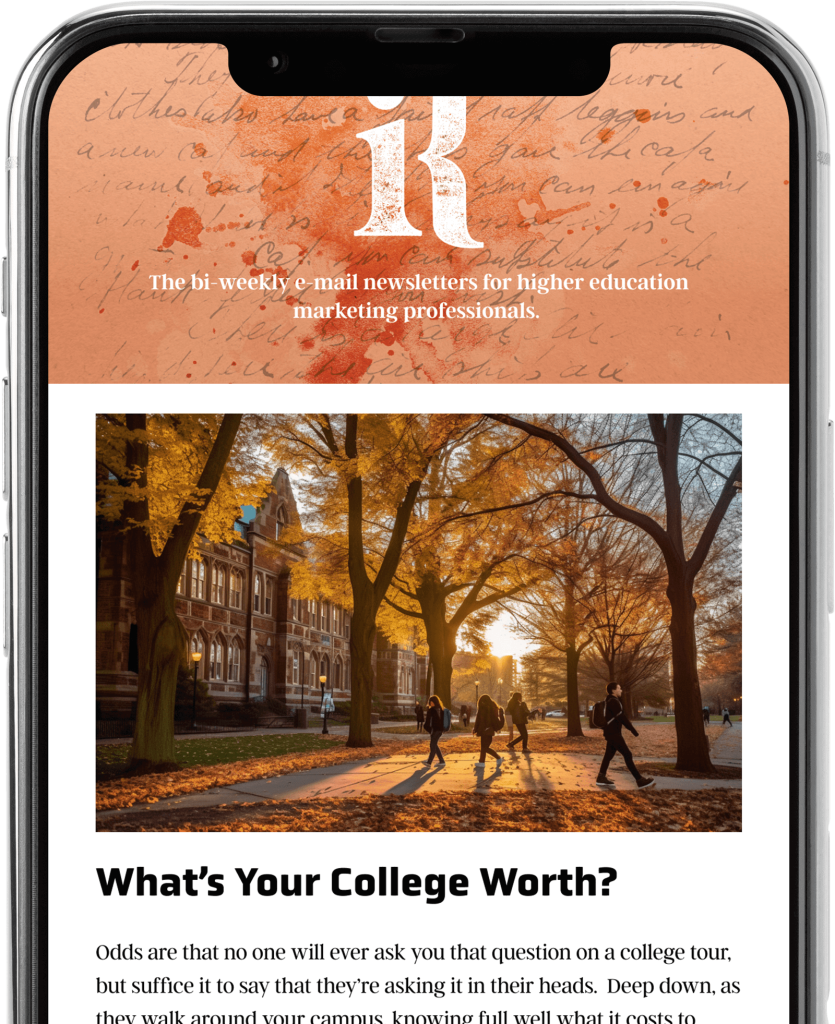Higher Education Marketing
Your Collegiate Brand and Your Students’ Self-Expression

I recently went to a big-time college football game with a stadium filled with 75,000+ fans rooting for the home team. Since I went to a smaller school and didn’t regularly experience this on Saturdays, I’m always blown away by this enormous display of college pride: the apparel, the signage, the vehicle wraps, the mascots.
Whether we’re focused just on higher ed marketing or the world of consumer marketing, brands are much more than just logos, slogans, or a set of colors. They’ve become a means of self-expression, particularly for younger generations like Generation Z. This concept, known as the self-expressive benefit of a brand, refers to how consumers—whether students, parents, or professionals—use brands to communicate something about their identity, values, and aspirations. For higher education institutions, this idea presents a unique opportunity to connect with prospective students on a deeper level, positioning the college experience as part of a student’s personal identity and life story.
Brands like Apple and Patagonia are powerful examples of how the self-expressive benefit works in the corporate world. Apple’s products, for instance, have become synonymous with creativity, individuality, and artistry. People who use Apple products don’t just appreciate their functionality; they feel that owning Apple products says something about their personality—that they are forward-thinking, creative, or tech-savvy.
Similarly, Patagonia taps into its consumers’ desire to experience the outdoors, experience a new adventure, and take care of the planet all at the same time. If you see a young person wearing a Patagonia shirt, they’re communicating all of these things buy actually paying to advertise the company logo.
The same principle can be applied in higher education, where students are choosing a college not just for the programs it offers, but for how attending that institution will help them define who they are. Research shows that 89% of consumers remain loyal to brands that share their values, and for prospective students, choosing a college is about finding an institution that reflects their identity, values, and future aspirations.
To harness the self-expressive benefit and attract more students, colleges need to think beyond traditional marketing and focus on how their brand can become part of a student’s personal story. Here are a few practical suggestions for higher education marketers to consider:
- Tell stories that resonate: Highlight student success stories, alumni achievements, and campus culture that align with the values and aspirations of prospective students. For example, a university with a strong entrepreneurial program could showcase alumni who’ve gone on to launch successful startups, framing the institution as a place for innovators and change-makers.
- Hold up your popular luminaries: Many colleges have really interesting and inspiring founding stories and brand heroes that have come through the ranks. One college we have worked with was founded by a famous entrepreneur that not only built a great company but also was an innovator in providing healthcare benefits to employees. It’s a huge opportunity to align this kind of value system with a student’s desire to create and do good in the world.
- Leverage social media for student-driven content: Students increasingly trust peer-generated content over traditional advertisements. Create opportunities for current students to share their personal experiences on platforms like Instagram, TikTok, and YouTube. User-generated content that highlights day-to-day campus life, study abroad experiences, or unique extracurricular activities can serve as authentic, compelling testimonials.
- Create personalized campus visits and digital experiences: We all know that a campus visit is key to an enrollment decision. By making these visits personalized—offering students experiences that highlight areas they care about (such as environmental sustainability, diversity initiatives, or athletic programs)—you tap into their self-identity and strengthen their connection to your institution. Virtual tours should do the same, allowing students to explore spaces and resources that matter most to them.
- Promote values that align with student priorities: According to a survey by the Chronicle of Higher Education, 76% of Generation Z students said they would be more likely to apply to institutions that demonstrate a commitment to diversity, equity, and inclusion (DEI). Highlighting how your college fosters these values—through initiatives, campus culture, or community involvement—can help prospective students feel aligned with your mission.
- Build communities that reflect student identities: Encourage prospective students to see themselves as part of your campus community before they even enroll. Through programs like early admissions events, mentorship programs, or online forums where admitted students can connect, you help them feel like they’re already a part of the larger brand of the institution.
- Highlight unique, purpose-driven programs: Colleges should emphasize programs that offer clear pathways to fulfilling a student’s personal goals. For example, environmental science programs can appeal to students passionate about climate change, while social justice programs might attract those who aspire to be activists or community leaders. Highlighting how your institution provides opportunities for students to live out their personal and professional values can create a powerful emotional connection.
When higher education institutions successfully connect their brand to a student’s identity, the result is a more emotionally engaged and loyal student body. Studies have shown that brands with strong emotional connections enjoy significantly higher loyalty and advocacy rates. This applies to colleges as well: students who feel that their institution aligns with their personal values are more likely to engage deeply in campus life, excel academically, and even donate as alumni.
In the end, the self-expressive benefit of a brand can turn a simple college choice into a lifelong relationship. By focusing on how your institution can become part of a student’s personal story, you don’t just fill classrooms—you create lasting emotional bonds that fuel retention, advocacy, and long-term success. Plus, you’ll sell more gear with your logo on it!
Like what you're reading?
Subscribe to our newsletter to get the latest insights in Higher Education and thought leadership.


